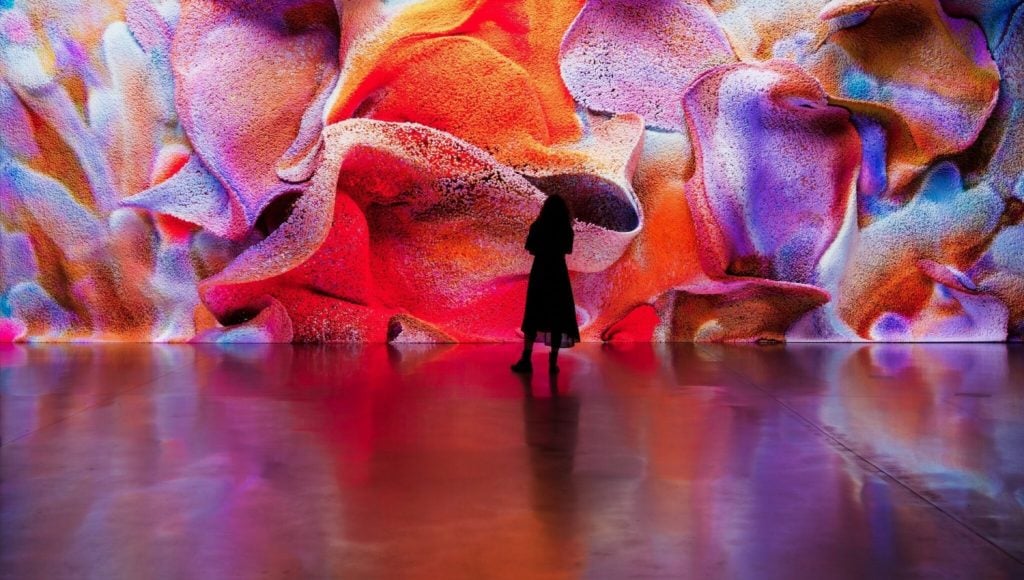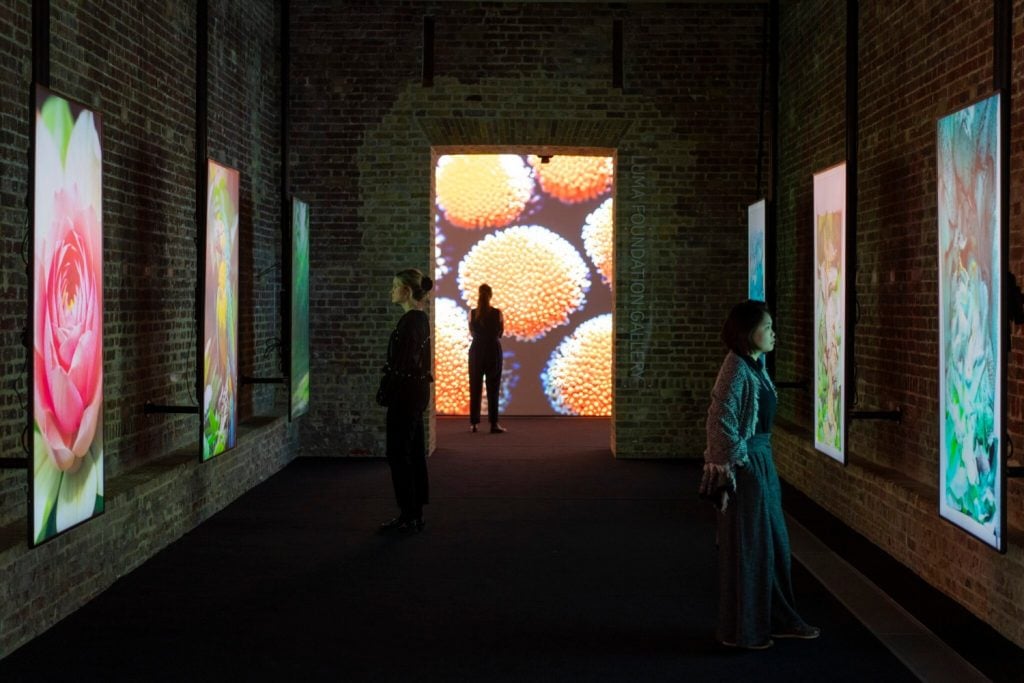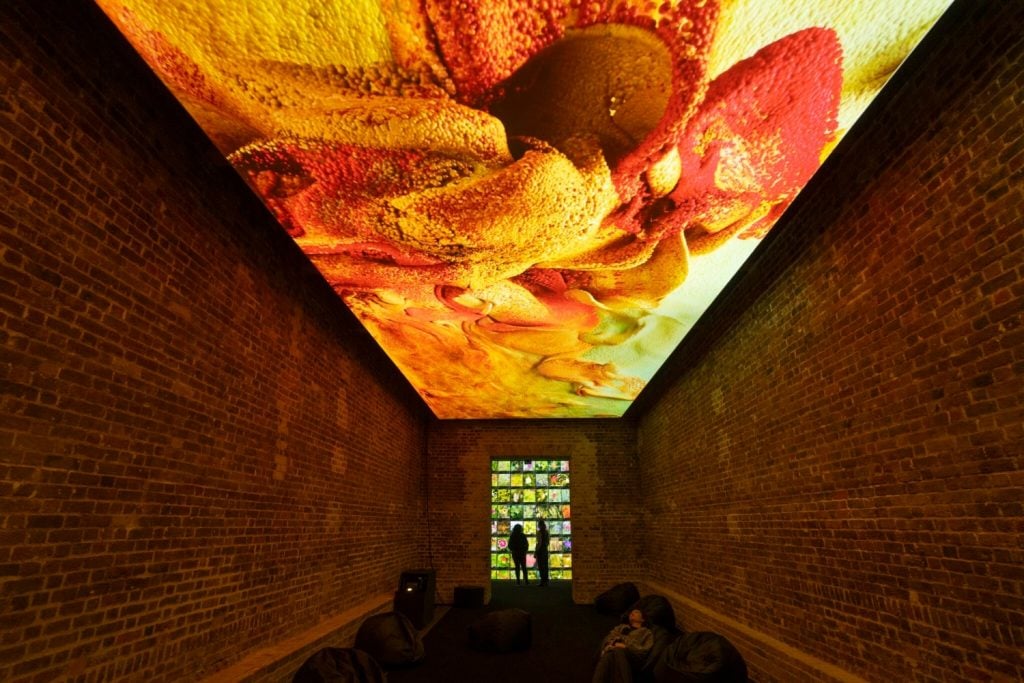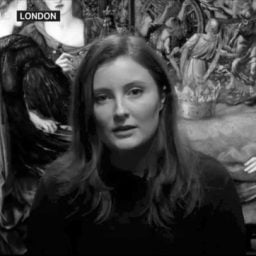On View
Refik Anadol’s New Show at Serpentine Blends Natural Imagery With a Slick A.I. Finish
Anadol's visuals are undoubtedly impressive, but don't expect much substance beneath these psychedelic surfaces.

We live in a time when, thanks to generative A.I., we can conjure almost any image we want in an instant. To which new worlds will we prompt this magic technology to take us? It seems that, in the face of overwhelming possibilities, there is a sudden craving to return to nature.
This has clearly been the impulse driving the world’s most famous A.I. artist, Refik Anadol. His new show “Echoes of the Earth: Living Archive,” opening February 16 at Serpentine North in London’s Kensington Gardens, presents three of his latest projects made using custom A.I. generators trained on images of coral reefs and the rainforest.
The exhibition has an immediately impressive visual impact of the kind that we can now reliably expect from Anadol. Unsupervised (2022), his splashy commission for New York’s Museum of Modern Art was an easy crowdpleaser that had its run extended until October 2023. Its fluid waves of surging and swirling color may have had a hypnotic effect on audiences, but such eye-catching theatrics could not convince the critics.
Artnet News’s Ben Davis dubbed it “an extremely intelligent lava lamp,” and New York‘s Jerry Saltz dismissed it as “a half-million-dollar screensaver,” eventually getting into an altercation with Anadol on X (Twitter).

Refik Anadol, Echoes of the Earth: Living Archive (2024) installation view at Serpentine North. Photo: Hugo Glendinning, courtesy Refik Anadol Studio and Serpentine.
Anadol’s growing celebrity paired with the current craze for all things A.I. makes this latest exhibit a total no-brainer for the Serpentine Galleries, but the same critiques stand. Short and sweet, the show invites audiences to wander through in idle wonder but they shouldn’t expect much substance beneath these psychedelic surfaces.
Living Archive: Large Nature Model (2024) is an immersive, field of moving images that wraps around the gallery’s perimeter walls. In a leafy expanse, animals metamorphose into each other. In one instance, a bear flickers and blurs until it mutates into an elephant.
Apparitions like these are made possible thanks to Anadol’s new open source Large Nature Model trained on freely available data provided by sources like the Smithsonian Institution, National Geographic and London’s Natural History Museum. The A.I. model can clearly reproduce imagery derived from the natural world, but the presentation doesn’t exactly prove that it can do much more than that. The feeling that one may as well be at the National History Museum’s annual Wildlife Photographer of the Year exhibition, where they could marvel at the real deal, needs to be suppressed.
Aesthetically, the three projects bleed into one another and its not always easy to tell where one starts and another ends. In one gallery lined with screens, a shape-shifting exotic bird is presumably part of Artificial Realities: Rainforest (2024). Nearby, a fuchsia pink coral-like formation surely belongs to Artificial Realities: Coral (2023).
Debuted at last year’s World Economic Forum, this surreal evocation of ocean environments is apparently intended to raise awareness of climate change. It is not clear that such an impact could offset A.I.’s considerable carbon cost.

Refik Anadol, Echoes of the Earth: Living Archive (2024) installation view at Serpentine North. Photo: Hugo Glendinning, courtesy Refik Anadol Studio and Serpentine.
A second gallery space is dotted with bean bags, inviting viewers to flop down and gaze up at a vast ceiling screen with undulating forms rippling over each other in avalanches of glowing green sand. The crashing sound of waves paired with sounds reminiscent of the “binaural beats” I sometimes play to induce deep concentration have a strongly meditative effect. It would be all too easy to get lulled into a trance and stare at the screen for an hour, an effect that Anadol is skilled in producing.
The potential of A.I. to reimagine organic forms in a way that feels new and exciting may be better evidenced by the work of other artists. Sofia Crespo’s Structures of Being, currently being projected onto Gaudí’s Casa Batlló in Barcelona, has been a huge success, reportedly drawing crowds of nearly 100,000. Also relying on open-source photographs of underwater fauna, it brings to life and builds upon Gaudí’s own inventive use of these biological forms over 100 years ago.
Last year, Crespo collaborated with Anna Ridler on Various and Casual Occursions, a highly experimental and complex work inspired by the techniques of women botanists from the Victorian era.
Compared to these explorations, Anadol’s inventions feel more like a proof of concept than anything we could honestly call conceptual. Right now, it is still exciting just to see what A.I. is capable of. Some day, audiences may hope to see something more intellectually stimulating than merely stupefying.
“Echoes of the Earth: Living Archive” runs at Serpentine North in London from February 16 through April 17, 2024.





